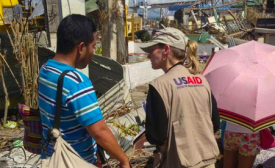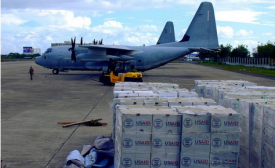philippines
On November, 8 2013, Super typhoon Haiyan, the strongest storm ever recorded, destroyed an area as big as Belgium and affected the lives of 14 million people in the central islands of the Philippines. Immediately following the storm, a surge of prominent international newsmakers and their crews descended on Tacloban and began live reporting from the disaster zone.
On November 8 Super Typhoon Haiyan (Yolanda) struck the central Philippines with devastating effect. The U.S. offered immediate assistance in disaster relief and the next day U.S. Marines began deploying to the Philippines. At a press conference on November 25, Philippines Secretary for Foreign Affairs Albert del Rosario stated that the U.S. response demonstrated the need for the early conclusion of a new agreement covering the U.S. military presence in the Philippines.
Since Typhoon Haiyan struck the Philippines a month ago, the world has wanted to help the devastated areas. Yet as we’ve seen in the wake of other mega-disasters, well-meaning assistance to shattered communities can cause more harm than good. Let’s lay to rest some of the biggest misconceptions about how best to help victims of storms, earthquakes and other calamities.
Public diplomacy (PD), if defined as the act of a government engaging directly with a foreign public, then many governments are currently conducting PD towards the Filipino public in the aftermath of Typhoon Haiyan's devastation. Most public diplomacy scholars and practitioners refer to the foreign aid assistance in the wake of a disaster as "aid diplomacy."

Public diplomacy (PD), if defined as the act of a government engaging directly with a foreign public, then many governments are currently conducting PD towards the Filipino public in the aftermath of Typhoon Haiyan's devastation. Most public diplomacy scholars and practitioners refer to the foreign aid assistance in the wake of a disaster as "aid diplomacy." This aid diplomacy is often spoken about in terms of foreign aid packages, goodwill gestures, and how foreign aid can help to increase a public's positive attitudes towards the aid-providing country.
Myanmar's president called Thursday for more investment and development assistance from the Philippines, saying his country needs help to catch up with the rest of Southeast Asia after emerging from nearly two decades of economic sanctions. President Thein Sein's visit represents a milestone in relations with the Philippines, one of the harshest critics of Myanmar's former ruling junta.
On November 8, 2013, Super Typhoon Haiyan ravished the Philippine archipelago. With 195 MPH winds and gusts of up to 230 MPH, the typhoon killed an estimated 4,000 people and displaced another 670,000. Across the southern part of the Philippines and especially in Tacloban, the city most affected by the typhoon, the scene is apocalyptic.

APDS Blogger: Shannon Haugh







